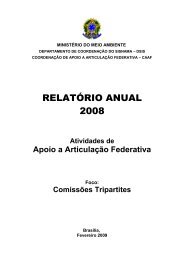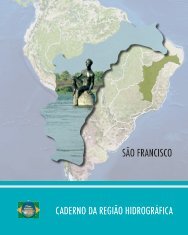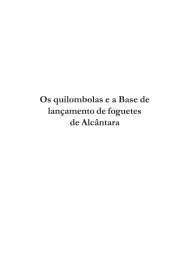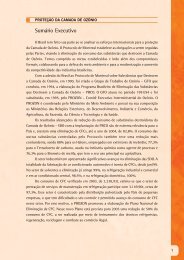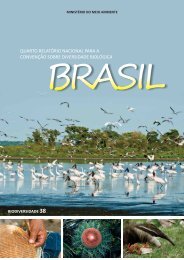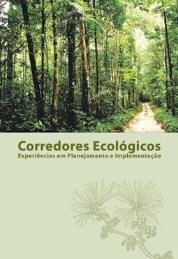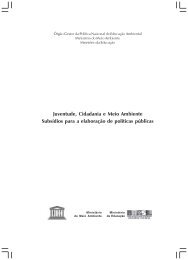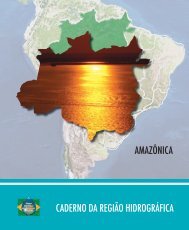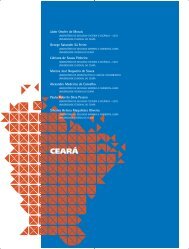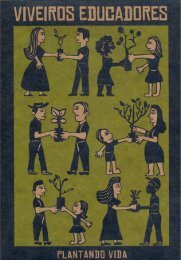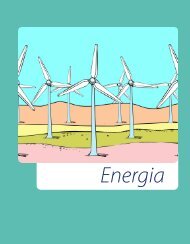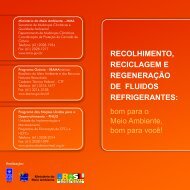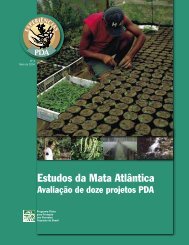Protected Areas
Protected Areas
Protected Areas
- No tags were found...
You also want an ePaper? Increase the reach of your titles
YUMPU automatically turns print PDFs into web optimized ePapers that Google loves.
developing the legal framework for itsconservation, increasing the area underprotection within the biome, improvingthe implementation of these areas andmonitoring deforestation within theCaatinga. Its specific objectives include:a) Updating the mapping of survivingareas and monitoring the vegetationcoverage of the biome;b) Monitoring and supporting the workof the National Council for the CaatingaBiosphere Reserve;c) Integrating actions of existing projectsfor the conservation and sustainable useof biodiversity in the Caatinga;d) Monitoring the policies, programmesand projects being carried out by theMinistry of the Environment and othergovernmental activities at the municipal,state and federal levels, in particularthose relating to the Conventions onBiological Diversity, DesertificationCombat and Climate Change, and therebyconstituting a key forum for dialogue withcivil society;e) Effectively establishing the CaatingaWorkin Group.The mandate the Caatinga WorkingGroup is to propose public policies forthe conservation and sustainable useof the Caatinga and programmes tothis end. The working group comprisesmore than fifteen institutions, includingrepresentatives of federal and stategovernments, non-governmentalorganizations and representatives ofthe scientific, agricultural and industrialsectors.The Cerrado BiomeThe Cerrado is the second largestbiome of South America and occupies2,036,448 Km² of land (22% ofthe entire Brazilian territory). Itscontinuous area extends into the statesof Goiás, Tocantins, Mato Grosso, MatoGrosso do Sul, Minas Gerais, Bahia,Maranhão, Piauí, Rondônia, Paraná,São Paulo and the Federal District, inaddition to insertions in the states ofAmapá, Roriama and Amazonas. Theheadsprings of South America’s threelargest hydrographic basins (Amazonas/Tocantins, São Francisco and Plata) arealocated in this territory, and thus yieldselevated water potential and favors itsbiodiversity.The Cerrado is considered to beone of the worldwide hotspots forbiodiversity and presents a significantabundance of endemic species andsuffers exceptional losses of habitat.From the point of view of biologicaldiversity, the Brazilian Cerrado is knownas the world’s richest savannahs. It ishome to over 6,500 species of alreadycataloguedplants, 44% of which are ofendemic flora. There is a wide array ofhabitats, which determine a noteworthyalternance of species among differentphytophysiognomies. Close to 199mammal species are known and therich avifauna includes approximately837 species. The number of fish (1200species), reptiles (180 species) andamphibians (150 species) is quiteelevated. The number of endemic fish isnot known, but the numbers are very highfor amphibians and reptiles – 28% and17%, respectively. According to recentestimates, the Cerrado is refuge to 13%of all of the tropic’s butterflies, to 35% ofall bees, and to 23% of all termites.In addition to the environmental aspects,the Cerrado has great social importance.Many traditional populations live off itsnatural resources, including indigenousethnic groups, quilombas, geraizeiros,27



